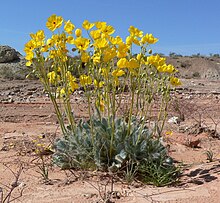| California bearpoppy | |
|---|---|

| |
| Conservation status | |
 Critically Imperiled (NatureServe) | |
| Scientific classification | |
| Kingdom: | Plantae |
| Clade: | Tracheophytes |
| Clade: | Angiosperms |
| Clade: | Eudicots |
| Order: | Ranunculales |
| Family: | Papaveraceae |
| Genus: | Arctomecon |
| Species: | A. californica |
| Binomial name | |
| Arctomecon californica Torr. & Frém. | |
Arctomecon californica is a species of poppy known by several common names, including California bearpoppy, Las Vegas bearpoppy, golden bearpoppy, and yellow-flowered desert poppy. It is a perennial herb that is native to the eastern Mojave Desert.
Description
Arctomecon californica is a herbaceous perennial found in Creosote bush (Larrea tridentata) habitats, in barren shales with gypsum substrates, at 500–1,000 metres (1,600–3,300 ft) in elevation.
The plant flowers in mid spring with deep yellow petals from large buds on tall 1–3 feet branching inflorescences. Fruiting occurs in early summer.
Distribution and habitat
Arctomecon californica is native to the eastern Mojave Desert: in areas around Las Vegas, Nevada such as Tule Springs; the Lake Mead area; in and around Las Vegas; and in extreme Mohave County in Northwestern Arizona. It is also known in Utah from a single collection in Washington County, characterized as having "apparently occurred in cultivation on private property".
Conservation
The species has declined dramatically in recent decades and has now been petitioned for listing on the US Endangered Species list. It is a protected species in Nevada and Arizona due to its rarity. It is declining in its primary habitat in Nevada. Populations have undergone a serious decline associated with land development and grazing and the growth in the European and Africanized honeybee population associated with the latter. Habitat fragmentation is a possible contributing factor to reduced levels of genetic variation in populations in the Las Vegas Valley.
Ecology
Arctomecon californica is pollinated by a specialist bee, the Mojave poppy bee. Pollination occurs by female Mojave poppy bees who collect pollen from the plants to feed their young. The Mojave poppy bee is imperiled due to habitat loss.
References
- NatureServe (6 December 2024). "Arctomecon californica | NatureServe Explorer". NatureServe Explorer. Arlington, Virginia. Retrieved 24 December 2024.
- "Arctomecon californica in Flora of North America @". Efloras.org. Retrieved 2022-05-01.
- "Lady Bird Johnson Wildflower Center - The University of Texas at Austin". Wildflower.org. Retrieved 10 May 2022.
- Welsh, Stanley; Atwood, N.; Goodrich, Sherel; Higgins, Larry (1987). A Utah Flora. Monte L Bean Life Science Museum.
- "Endangered Species | Species | U.S. Species". Fws.gov. Retrieved 10 May 2022.
- Hickerson, Laura L.; Wolf, Paul G. (1998). "Population Genetic Structure of Arctomecon californica Torrey and Fremont (Papaveraceae) in Fragmented and Unfragmented Habitat". Plant Species Biology. 13 (1): 21–33. doi:10.1111/j.1442-1984.1998.tb00245.x.
- "Nevada's Highly Imperiled Mojave Poppy Bee Takes Step Toward Endangered Species Act Protection". Center for Biological Diversity. Retrieved 2022-04-21.
- "NatureServe Explorer 2.0". Explorer.natureserve.org. Retrieved 2022-04-21.
External links
| Taxon identifiers | |
|---|---|
| Arctomecon californica | |
This Papaveraceae article is a stub. You can help Misplaced Pages by expanding it. |